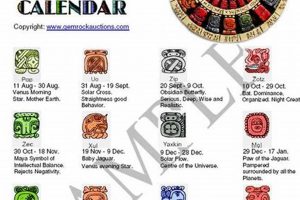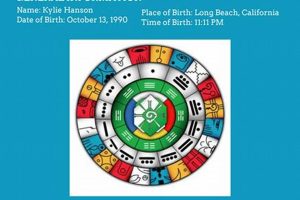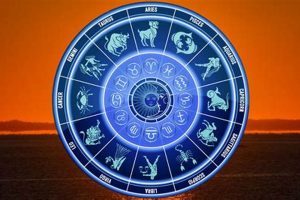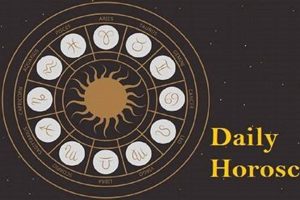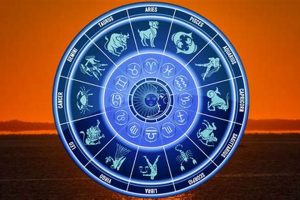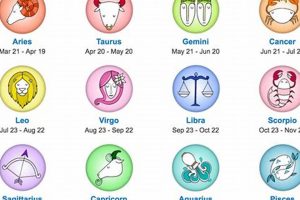Mayan astrology assigns individuals a specific day sign based on their birth date within the Mayan calendar, a complex system encompassing various interconnected cycles. This calendar incorporates a 260-day sacred calendar known as the Tzolkin, which intertwines 20 day signs with 13 numbered days, creating unique combinations. For example, someone born on a day designated as 8 Ajpu would have Ajpu as their day sign. Understanding one’s day sign provides insight into perceived personality traits, strengths, weaknesses, and destiny according to Mayan beliefs.
This practice provides a framework for self-discovery and reflection within a rich cultural context. Rooted in ancient Mesoamerican traditions, the Mayan calendar and its associated astrology offer a connection to a sophisticated worldview that observed the cyclical nature of time and its influence on human life. By understanding their placement within these cycles, individuals could potentially gain a deeper understanding of their purpose and navigate life’s challenges. The system offers a lens through which to interpret one’s characteristics and potential, enriching one’s personal narrative.
The following sections will delve further into the intricacies of the Mayan calendar, explore each of the 20 day signs and their associated meanings, and provide guidance on calculating one’s day sign. Additionally, we will examine the historical significance of Mayan astrology and its enduring relevance in contemporary society.
Tips for Understanding Mayan Astrology
Gaining a deeper understanding of Mayan astrology requires more than simply identifying one’s day sign. The following tips offer guidance for a more comprehensive exploration:
Tip 1: Explore the Tzolkin Calendar: Familiarization with the structure and intricacies of the 260-day Tzolkin calendar is crucial. This calendar forms the foundation of Mayan astrology and understanding its cyclical nature provides context for the day signs.
Tip 2: Research the Day Sign Meanings: Each of the 20 day signs possesses unique characteristics and symbolism. In-depth research into one’s specific day sign reveals potential strengths, weaknesses, and life path predispositions.
Tip 3: Consider the Numbers: The Tzolkin calendar combines day signs with numbers 1 through 13. The number associated with one’s birth date adds another layer of interpretation, influencing the expression of the day sign’s energies.
Tip 4: Consult Reputable Sources: The abundance of information available requires careful discernment. Seek out reputable sources grounded in scholarly research and traditional Mayan knowledge to ensure accuracy and avoid misinterpretations.
Tip 5: Embrace the Holistic Perspective: Mayan astrology is best understood within its larger cultural and spiritual context. Exploring Mayan cosmology, mythology, and rituals provides a richer appreciation for the significance of the day signs.
Tip 6: Avoid Oversimplification: Mayan astrology is a complex system. Avoid reducing its interpretations to simplistic generalizations. Recognize the nuances and interconnectedness of its various elements.
Tip 7: Use it as a Tool for Self-Reflection: Mayan astrology offers a framework for self-discovery, not a definitive prediction of one’s fate. Use it as a tool for introspection and personal growth, rather than a rigid determinant of one’s life path.
By incorporating these tips, individuals can navigate the complexities of Mayan astrology with greater clarity and insight, fostering a more meaningful understanding of this ancient system and its potential for personal exploration.
This exploration of Mayan astrology provides a foundational understanding. Further research and engagement with the subject will undoubtedly yield a richer and more nuanced comprehension of this fascinating tradition.
1. Tzolkin Calendar
The Tzolkin calendar is essential for determining a Mayan astrology sign. This 260-day sacred calendar forms the foundation of Mayan astrology, providing the framework for understanding individual destinies and characteristics. Exploring its structure reveals its intricate connection to the concept of a Mayan day sign.
- Cycle of Days and Numbers
The Tzolkin calendar combines a cycle of 20 named days with a cycle of 13 numbered days. Each day within the 260-day period has a unique combination of a day name and a number. This combination is crucial for determining an individual’s Mayan day sign. For example, a person born on 1 Ik’ would have a different day sign than someone born on 8 Ik’.
- The 20 Day Signs
Each of the 20 day signs holds specific meanings and is associated with distinct energies and characteristics. These signs represent various aspects of nature, animals, and deities, providing insight into an individual’s personality, strengths, and weaknesses. Knowing the day signs is crucial for understanding a Mayan astrology reading.
- The 13 Numbered Days
The 13 numbered days add another layer of complexity to the Tzolkin calendar. These numbers interact with the day signs, modifying their energetic influence. The number associated with one’s birth date influences how the energies of the day sign manifest. Understanding this interaction is key to a nuanced interpretation of one’s Mayan astrology sign.
- Calculating the Day Sign
Determining one’s Mayan day sign requires correlating the Gregorian calendar birth date with the corresponding day in the Tzolkin cycle. Various resources and calculators exist to facilitate this conversion, allowing individuals to discover their specific day sign and its associated characteristics. This process represents the practical application of the Tzolkin calendar in determining one’s Mayan astrology sign.
The Tzolkin calendar, through its unique combination of day signs and numbers, provides the structure for understanding individual placement within Mayan cosmology. It acts as a map, guiding individuals toward a deeper understanding of their characteristics and potential life path as envisioned by the ancient Maya. It offers a framework for self-reflection and personal growth based on a sophisticated system of cyclical time.
2. Birth Date
Birth date plays a pivotal role in determining a Mayan day sign. The Mayan calendar system, unlike the Gregorian calendar, operates on various interconnected cycles. The Tzolkin, or sacred calendar, a 260-day cycle, is paramount for astrological interpretations. An individual’s birth date is converted into its corresponding position within the Tzolkin calendar. This position reveals the specific day sign governing personality traits and destiny according to Mayan belief. For instance, a birth date corresponding to 1 Imix within the Tzolkin calendar designates Imix as the individual’s day sign.
This correlation between birth date and day sign underscores the Mayan worldview regarding time as a cyclical influence on human existence. Each day within the Tzolkin cycle possesses unique energetic qualities. Birth date, therefore, acts as a gateway to understanding these energies and their influence on an individual’s life path. This understanding offers potential insights into one’s strengths, weaknesses, and predispositions. By converting one’s birth date into its Tzolkin equivalent, individuals gain access to this personalized information embedded within the Mayan calendrical system. The process demonstrates a practical application of ancient knowledge for self-discovery.
In summary, birth date serves as the key to unlocking one’s Mayan day sign. This conversion process reveals the specific energetic influences associated with one’s birth, providing potential insight into personal characteristics and destiny as envisioned by Mayan cosmology. The practice highlights the importance of birth date as a starting point for exploring one’s placement within the cyclical framework of Mayan time. It provides a tangible link between the modern Gregorian calendar and the ancient wisdom embedded within the Tzolkin calendar.
3. Day Sign
Within Mayan astrology, the “day sign” represents the core element answering the question, “what is my Mayan astrology sign?”. It functions as the individual’s primary astrological identifier, derived from their birth date within the Tzolkin calendar, the 260-day sacred calendar of the Maya. Understanding the nuances of the day sign provides the foundation for interpreting personal characteristics, inherent strengths, weaknesses, and potential life path as perceived through the lens of Mayan cosmology.
- Derivation from the Tzolkin Calendar
The Tzolkin calendar, a cycle of 20 named days interwoven with 13 numbered days, determines an individual’s day sign. A birth date corresponds to a specific day within this cycle, assigning one of the 20 day signs to the individual. For example, a birth date aligning with the day “8 Ajpu” within the Tzolkin calendar results in “Ajpu” as the day sign. This process establishes the fundamental connection between birth date and day sign.
- Symbolic Meanings and Associations
Each day sign carries unique symbolic meanings and associations. These symbols often relate to natural phenomena, animals, or deities within Mayan mythology. For instance, the day sign “Imix” is associated with primordial waters and creation, while “Kan” represents the serpent and life force. These symbolic associations provide layers of meaning for interpreting the day sign’s influence.
- Influence on Personality and Characteristics
Mayan astrology suggests the day sign exerts influence over an individual’s personality, strengths, and weaknesses. Those born under the sign “Oc,” for example, are often perceived as strong-willed and independent, while those born under “Chuen” are seen as artistic and creative. These ascribed characteristics offer potential insight into an individual’s inherent predispositions according to Mayan tradition.
- Interplay with Numbered Days
While the day sign provides the primary astrological designation, the 13 numbered days of the Tzolkin calendar introduce further nuance. The number associated with one’s birth date interacts with the day sign, modulating its energetic influence. Therefore, 1 Imix differs from 4 Imix, even though both share the same day sign. This interplay adds complexity to Mayan astrological interpretations.
The day sign, therefore, constitutes the cornerstone of Mayan astrology, providing the essential link between an individual’s birth date and their perceived characteristics and destiny within the Mayan worldview. Understanding the day sign’s derivation, symbolic associations, and its interplay with the numbered days allows for a more comprehensive interpretation of Mayan astrology, moving beyond simple identification to a richer appreciation of its cultural and cosmological context.
4. Numbered Day
The numbered day, a crucial component within the Mayan Tzolkin calendar, adds a layer of complexity to understanding one’s Mayan astrology sign. While the day sign itself provides the primary astrological association, the numbered day, ranging from 1 to 13, significantly modifies the day sign’s energetic influence. This interplay between day sign and numbered day creates a more nuanced and personalized interpretation than considering the day sign alone. The numbered day essentially acts as a lens through which the day sign’s energies are focused and expressed, impacting how these energies manifest in an individual’s life. This concept is essential when exploring “what is my Mayan astrology sign?”.
Consider the day sign Imix. If an individual’s Mayan astrology sign is 1 Imix, the inherent qualities of Imix, such as primal energy and new beginnings, are expressed with a direct and initiating force. However, if the sign is 4 Imix, the same Imix energies are channeled through a lens of stability and organization. This difference demonstrates the numbered day’s influence. Another example is the day sign Kan. 8 Kan might emphasize leadership and empowerment, whereas 12 Kan might manifest as a focus on introspection and spiritual development. These variations demonstrate the practical significance of the numbered day in shaping the specific expression of each day sign.
Understanding the numbered day is therefore crucial for a comprehensive understanding of Mayan astrology. It provides a level of detail that distinguishes individuals born on different days within the Tzolkin calendar, even if they share the same day sign. This nuanced perspective enhances the interpretive depth of Mayan astrology, allowing for a more personalized and insightful exploration of one’s characteristics, strengths, and potential life path. Recognizing the influence of the numbered day offers a more complete answer to the question “what is my Mayan astrology sign?”. It moves beyond a simple association with a day sign to a deeper understanding of the energetic nuances at play.
5. Personal Interpretation
Personal interpretation forms a critical bridge between the objective data of the Mayan calendar and the subjective experience of understanding one’s Mayan astrology sign. While calculating the day sign and numbered day provides a foundational framework, personal interpretation breathes life and meaning into these elements. It acknowledges that astrological information is not deterministic but rather offers a lens through which individuals can understand themselves and their place within the cosmos. The interaction between calculated data and personal reflection is essential to gaining a nuanced and meaningful answer to “what is my Mayan astrology sign?”.
Consider two individuals sharing the same day sign, Men. One might interpret Men’s association with the eagle and intellectual prowess as a call to pursue academic endeavors. Another, recognizing Men’s connection to leadership, might focus on developing managerial skills. Both interpretations are valid within the framework of Men’s symbolism, showcasing the role of individual perspective in shaping how astrological information is integrated into one’s life. Further, the influence of the numbered day adds another layer for personal interpretation. For example, 3 Men might be interpreted differently than 11 Men, even though both share the core characteristics associated with Men. One might see 3 Men as emphasizing creativity and artistic expression, while 11 Men might be seen as highlighting introspection and spiritual growth.
Effective personal interpretation requires a balance between understanding the traditional meanings associated with Mayan day signs and numbered days and applying this knowledge to one’s individual circumstances, aspirations, and experiences. Challenges can arise when interpretations become overly rigid or deterministic, negating the potential for growth and change. The value of Mayan astrology, like any astrological system, lies not in predicting the future but in offering a framework for self-discovery and exploration. Personal interpretation allows individuals to actively engage with this framework, shaping its insights into a meaningful narrative that empowers personal growth and understanding. Ultimately, it transforms the question “what is my Mayan astrology sign?” into a springboard for deeper self-reflection and a more profound connection to Mayan cosmology.
Frequently Asked Questions about Mayan Astrology Signs
This section addresses common inquiries regarding Mayan astrology signs, providing clarity on potential misconceptions and offering further insight into this complex system.
Question 1: How is a Mayan astrology sign different from a Western zodiac sign?
Mayan astrology utilizes the 260-day Tzolkin calendar, focusing on day signs, while Western astrology employs a 12-sign zodiac based on the sun’s apparent path throughout the year. These systems differ in their calendars, interpretations, and cultural origins.
Question 2: Can one’s Mayan day sign predict the future?
Mayan astrology, rather than offering predictions, provides a framework for understanding personality traits and potential life paths. It encourages self-reflection and personal growth based on the perceived energies associated with one’s day sign.
Question 3: Are there negative Mayan day signs?
Each day sign possesses unique strengths and weaknesses. No day sign is inherently negative; rather, each presents opportunities for growth and understanding. The system emphasizes balance and the cyclical nature of energies.
Question 4: How does the numbered day influence the day sign?
The numbered day, ranging from 1 to 13, modifies the expression of the day sign’s energies. It adds a layer of nuance and personalization, differentiating individuals born on different days within the Tzolkin calendar, even if they share the same day sign.
Question 5: What is the significance of the Haab calendar in Mayan astrology?
While the Tzolkin calendar determines the day sign, the 365-day Haab calendar, closer to the Gregorian calendar, provides additional context regarding agricultural cycles and seasonal influences. Some interpretations incorporate both calendars for a more comprehensive reading.
Question 6: Where can one find reliable resources for further exploration of Mayan astrology?
Reputable resources for further exploration include scholarly works on Mayan culture and cosmology, as well as resources authored by individuals knowledgeable in traditional Mayan practices. Discernment is advised when navigating online information, favoring sources grounded in established knowledge.
Understanding the nuances of Mayan astrology requires ongoing exploration and engagement. These frequently asked questions provide a starting point for further research and a deeper appreciation of this rich and complex system.
The following section will delve into detailed descriptions of each of the 20 Mayan day signs.
What is My Mayan Astrology Sign
Determining one’s Mayan astrology sign involves understanding the intricate workings of the Tzolkin calendar. This 260-day cycle, comprised of 20 unique day signs and 13 numbered days, provides the framework for identifying an individual’s specific day sign based on their birth date. Each day sign carries symbolic meaning and perceived influence over personality traits, strengths, and weaknesses. The numbered day further refines these influences, adding a layer of nuance to the interpretation. Ultimately, one’s Mayan astrology sign represents a point of entry into a complex system of beliefs regarding time, destiny, and the interconnectedness of all things.
The exploration of Mayan astrology offers a glimpse into a rich cultural heritage and a sophisticated system of understanding the human experience within the cosmos. Further research and engagement with Mayan cosmology can deepen this understanding, fostering a greater appreciation for the enduring legacy of Mayan knowledge and its potential relevance for self-discovery in the present day. The journey of understanding one’s Mayan sign is an invitation to explore not only the specifics of an ancient calendar but also the broader questions of identity, purpose, and the cyclical nature of existence.


